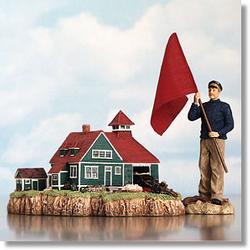Point Allerton
Since Christopher Columbus and early explorers sailed to America and proved the world was round, men and women have been lured to the Land of Opportunity. They soon discovered, however, that while the earth was not flat, neither was the sea nor the floor underneath it. What lay between them and America was her incredibly dangerous coastline, full of hidden rocks, reefs, and sand bars -- not to mention a tendency toward violent storms. Death by shipwreck was much more likely and no less horrifying than falling off the end of the earth. While some made it past the obstacles to stake their claim, far too many were themselves claimed by the sea.
In 1784, Dr. Mayes, a British physician, arrived in Boston and began stirring up interest in a society to rescue shipwreck victims. Soon the Humane Society of the Commonwealth of Massachusetts was born. Among its supporters: Paul Revere, Dr. Samuel Adams, John Hancock, and President George Washington.
Yet, even with these famous minds behind it, the Society’s beginnings were humble. The House of Refuge on Lowell’s Island off Boston was the first of many huts built along the Massachusetts’ coast. It was built for only $40. If shipwreck victims miraculously made it to shore alive, they would find in the huts provisions that could make the difference between life or death: blankets, food, candles, a tinderbox, and kindling.
The reality was that most of the huts stood unattended and were themselves victims of theft, vandalism, mice, and lack of maintenance. Still, lives were saved. And the foundation of American maritime rescue work was laid. In 1807, the first life saving vessel was completed at Cohasset -- a 30 foot long whale boat rowed by ten men. By 1872, there were 76 lifeboat stations (consisting of 20 x 8 ft. houses sheltering boats and equipment) plus eight houses of refuge still in use. One full-time keeper was appointed to each station. Volunteers manned the boats and were paid for rescues. In especially difficult circumstances, they received medals. The state of Massachusetts and the federal government even provided some sporadic financial assistance.
All these advancements stayed within the boundaries of Massachusetts until 1848, when New Jersey Congressman William A. Newell, another physician, strongly supported government involvement in life-saving. As with so many life-saving advocates, Newell had witnessed a catastrophic shipwreck and was horrified at the lack of preparedness outside Massachusetts. His efforts resulted in the appropriation of $10,000 for surfboats and supplies on the coast of New Jersey.
It wasn’t until the infamous winter of 1870-71 -- a winter of one terrifying fatal shipwreck after another along the Atlantic coast and on the Great Lakes -- that Congress finally recognized the importance of an adequate lifesaving system. They authorized $200,000 toward the cause.
Enter Sumner Kimball. Highly intelligent, well organized, efficient and honest -- not to mention, deeply caring -- he couldn’t have been better equipped for the job that lay ahead. He was named head of both the life-saving stations and the Revenue Marine Bureau.
Before he spent a dime of the appropriation, he directed Marine Captain John Faunce to visit the stations and report on their condition. Faunce found them deplorable: dilapidated and filthy huts, set much too far apart to adequately serve.
Kimball set to work to clean up the mess. He knew he needed to change the public’s ambivalence about life-saving. He also understood the power of the written word. Journalist William O'Connor was hired as assistant to the General Superintendent. O'Connor's heartfelt, eloquent and vivid accounts of the life-saving service’s rescues helped win the support of politicians and the public.
Incompetent station keepers were replaced. Skilled crews were selected and assigned. Written regulations governed operations, and they were quite strict. Newer and larger stations were built.
To say that the changes made a big difference would be to greatly understate their effect. There was a phenomenal 87.5% decrease in shipwreck deaths that fell in the domain of the Life-Saving Service.
Kimball served the entire span of the life-saving service until it ended in 1915, governing a total of 279 Life Saving Stations.
Point Allerton Life Saving Station
A perfect example of Sumner Kimball’s successful impact is the Point Allerton Life Saving Station, opened in 1889 at Hull, southeast of Boston. In our limited edition replica, you can see the station as it was near the turn of the century, prepared to send out rescuers at a moment’s notice. In the tower, a surfman stood watch -- quite literally, because no chairs were allowed in the lookout. Another surfman patrolled the beach, night and day, through thick fog and thin, looking for wrecks. When he spotted one, he would light a Coston signal. The red flare told the victims that help was on its way, while also alerting the station that there was trouble. The station’s keeper assessed the situation and decided what method of rescue to try first, either the boat, the lifecar (the capsule located near the cart) or the breeches buoy (a buoy with a seat sewn into it.) The Lyle gun was used to send a rope out to the ship, on which the breeches buoy or lifecar would be rigged. The weather was usually horrendous. Each method required practiced and perfected teamwork, and bravery beyond measure.
Point Allerton holds the honor of being our first featured Life Saving Station. The reasons are many. Today it is a beautifully restored museum that houses an intriguing collection of memorabilia from the life saving stations. But long before, Point Allerton was a very active station, with its own proud history -- a history teeming with stories of courage and heroism. Its greatest distinction was held by its first keeper, Joshua James. James was by far the most famous life-saver in American History. It isn’t difficult to understand why.
Product Reviews
There are currently no customer reviews for this product.
Be the first to write a review!
We value your opinion. Please take a moment and share what you like or don't like about a product.







